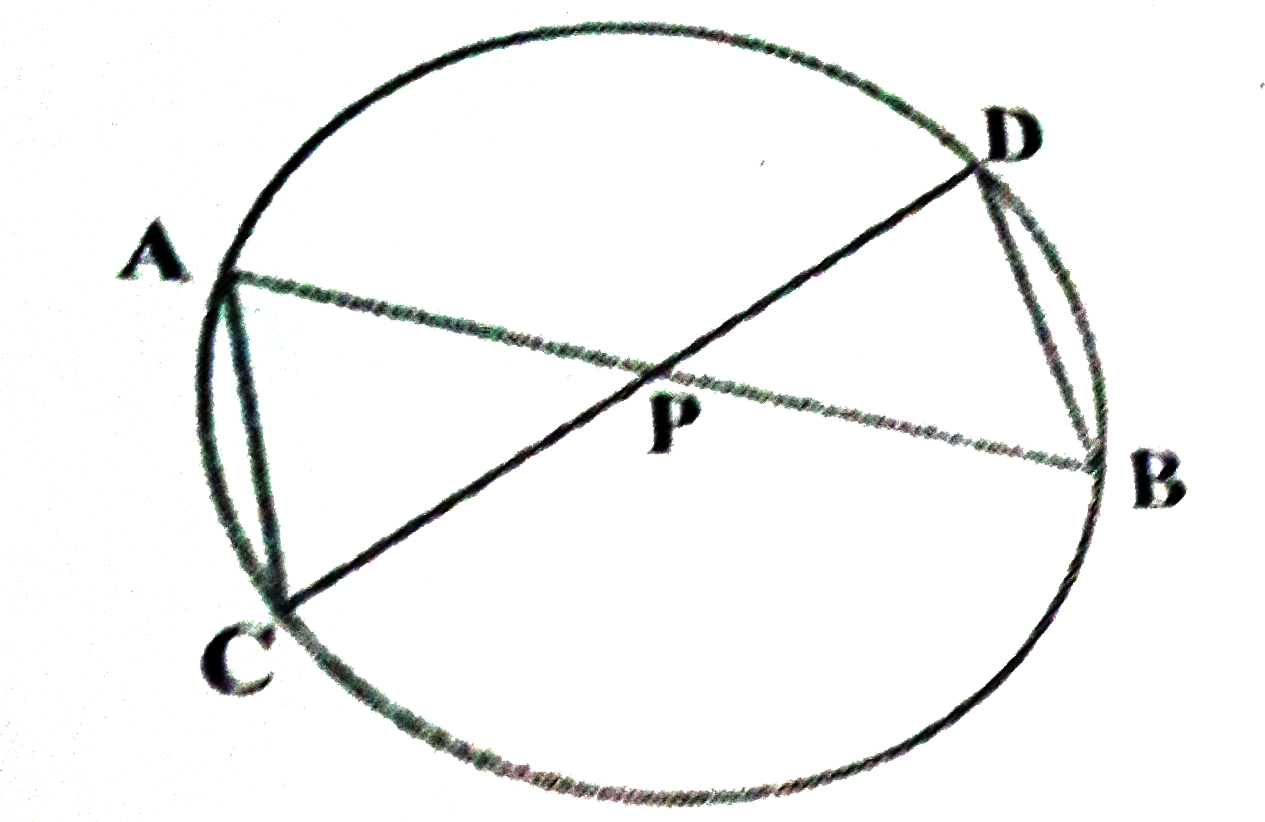ABCD
is a cyclic
quadrilateral whose diagonals AC and BD
intersect
at P.
If AB=DC,
prove that:
(i) PAB ≅PDC
(ii) PA=PD and PC=PB
(iii) AD∣∣BC
To solve the problem step by step, we will prove each part of the question regarding the cyclic quadrilateral ABCD with diagonals AC and BD intersecting at point P and given that AB=DC.
1. Identify the triangles: We are considering triangles PAB and PDC.
2. Show that PA=PC: Since A and C are points on the same circle with center O, the segments PA and PC are both radii of the circle. Therefore, PA=PC.
3. Show that PB=PD: Similarly, since B and D are also points on the same circle, the segments PB and PD are both radii of the circle. Thus, PB=PD.
4. Show that ∠APB=∠CPD: Angles APB and CPD are vertically opposite angles, which means ∠APB=∠CPD.
5. Apply SAS Congruence: We have two sides and the included angle of triangle PAB equal to the corresponding two sides and included angle of triangle PDC. Therefore, by the Side-Angle-Side (SAS) criterion, △PAB≅△PDC.
(ii) Prove that PA=PD and PC=PB
1. Using CPCTC: Since we have established that △PAB≅△PDC, we can use the property of congruent triangles which states that corresponding parts of congruent triangles are equal (CPCTC).
2. Conclude: Therefore, from the congruence, we have PA=PD and PC=PB.
(iii) Prove that AD∥BC
1. Consider triangles PAD and PBC: We will show that these triangles are congruent.
2. Show that PA=PC: As established earlier, both are radii of the circle, so PA=PC.
3. Show that PB=PD: Similarly, both are also radii of the circle, hence PB=PD.
4. Show that ∠APD=∠PBC: Angles APD and PBC are vertically opposite angles, thus ∠APD=∠PBC.
5. Apply SAS Congruence: We have two sides and the included angle of triangle PAD equal to the corresponding two sides and included angle of triangle PBC. Therefore, by SAS, △PAD≅△PBC.
6. Use CPCTC: From the congruence, we have ∠PBC=∠PDA. Since these angles are alternate interior angles formed by transversal PD cutting lines AD and BC, we conclude that AD∥BC.
2. Show that PA=PC: Since A and C are points on the same circle with center O, the segments PA and PC are both radii of the circle. Therefore, PA=PC.
3. Show that PB=PD: Similarly, since B and D are also points on the same circle, the segments PB and PD are both radii of the circle. Thus, PB=PD.
4. Show that ∠APB=∠CPD: Angles APB and CPD are vertically opposite angles, which means ∠APB=∠CPD.
5. Apply SAS Congruence: We have two sides and the included angle of triangle PAB equal to the corresponding two sides and included angle of triangle PDC. Therefore, by the Side-Angle-Side (SAS) criterion, △PAB≅△PDC.
2. Conclude: Therefore, from the congruence, we have PA=PD and PC=PB.
2. Show that PA=PC: As established earlier, both are radii of the circle, so PA=PC.
3. Show that PB=PD: Similarly, both are also radii of the circle, hence PB=PD.
4. Show that ∠APD=∠PBC: Angles APD and PBC are vertically opposite angles, thus ∠APD=∠PBC.
5. Apply SAS Congruence: We have two sides and the included angle of triangle PAD equal to the corresponding two sides and included angle of triangle PBC. Therefore, by SAS, △PAD≅△PBC.
6. Use CPCTC: From the congruence, we have ∠PBC=∠PDA. Since these angles are alternate interior angles formed by transversal PD cutting lines AD and BC, we conclude that AD∥BC.
Topper's Solved these Questions
Similar Questions
ABCD is a cyclic quadrilateral whose diagonals ACandBD intersect at P . If AB=DC, Prove that : PAB≅PDC PA=PDandPC=PB ADllBC
View SolutionABCD is a cyclic quadrilateral in which BA and CD when produced meet in E and EA=ED. Prove that: (i)ADisparalleltoBC (ii) EB=EC
View SolutionABCD is a parallelogram whose diagonals intersect at O. If P is any point on BO, prove that: ar (△ ABP)= ar (△ CBP)
View SolutionABCD is a parallelogram whose diagonals AC and BD intersect at O. A line through O intersects AB at P and DC at Q. Prove that ar ( △POA)= ar ( △QOC).
View SolutionABCD is a cyclic quadrilateral in which AC and BD are its diagonals. If ∠DBC=550 and ∠BAC=450, find ∠BCD
View SolutionABCD is a cyclic quadrilateral in which ∠BAD=750, ∠ABD=580and ∠ADC=770, AC and BD intersect at P. then, find ∠DPC
View SolutionThe diagonals of quadrilateral ABCD, AC and BD intersect in O. Prove that if BO=OD, the triangles ABC and ADC are equal in area.
View SolutionDiagonals AC and BD of a quadrilateral ABCD intersect each at P. Show that: ar(△APB)x ar (△CPD)= ar ( △APD) x ar ( △PBC)
View SolutionIn Figure, two chords AB and CD intersect each other at the point P. Prove that:
(i) ΔAPC~ΔDPB
(ii) AP⋅PB=CP⋅DP
 View Solution
View SolutionIn Figure, AN and CP are perpendicular to the diagonal BD of a parallelogram ABCD. Prove that :
(i) ADN≅CBP
(ii) AN=CPView Solution
